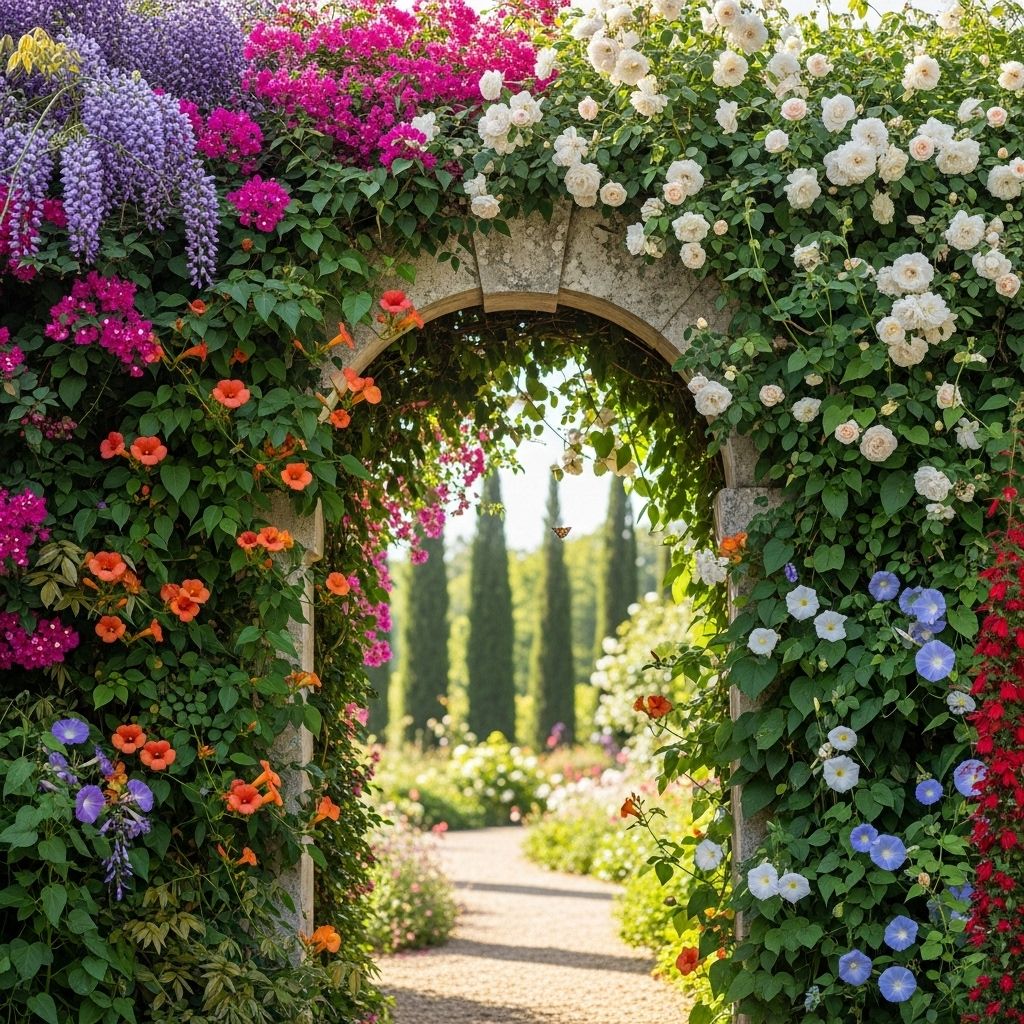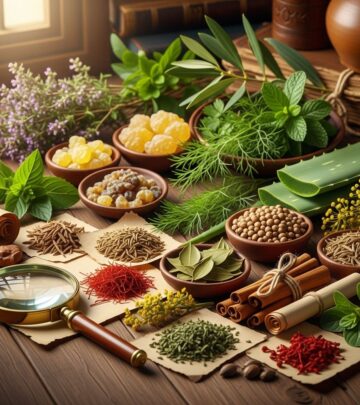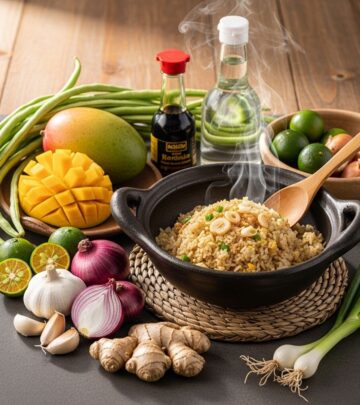Flowering Vines: 33 Stunning Options To Transform Outdoor Space
Discover stunning flowering vines that can quickly transform walls, trellises, and fences into vibrant vertical gardens

Image: HearthJunction Design Team
Beautiful Flowering Vines to Transform Your Outdoor Space
When it comes to maximizing garden beauty in minimal space, few plants offer the versatility and impact of flowering vines. These botanical wonders can transform plain walls, worn fences, and simple trellises into spectacular vertical gardens bursting with color and life. Whether you’re looking to add privacy, disguise an unsightly area, or simply bring more flowers into your landscape, vines deliver impressive results with relatively little effort.
From beloved classics like clematis, bougainvillea, and wisteria to lesser-known gems that deserve more attention in home gardens, the world of flowering vines offers something for every gardener’s taste and growing conditions. Many of these vines grow quickly, allowing you to enjoy dramatic transformations within a single growing season.
This comprehensive guide explores 33 beautiful flowering vines that can elevate your garden design. We’ll cover their growing requirements, bloom characteristics, and tips for success to help you select the perfect climbing plants for your outdoor space.
Cup and Saucer Vine (Cobaea scandens)
The Cup and Saucer Vine, also known as Mexican climbing cobaea, made its debut in American gardens in 1792 and has been charming gardeners ever since with its distinctive blooms. This rapid climber earns its name from the unique shape of its flowers, which truly resemble a cup sitting in a saucer.
What makes this vine particularly fascinating is the transformation of its flowers. They begin as green buds that develop into bell-shaped blossoms adorned with delicate violet stripes. As they mature, the flowers evolve into a rich royal purple hue before completing their lifecycle. This color-changing display creates ongoing visual interest throughout the growing season.
Cup and Saucer Vine thrives in USDA Hardiness Zones 9 to 11 and requires full sun exposure to produce its abundant blooms. In colder climates, it can be grown as an annual, where it will still reach impressive heights within a single season. The vine’s vigorous growth makes it perfect for covering arbors, trellises, or fences in a relatively short time.
Crossvine (Bignonia capreolata)
Crossvine is a spectacular native North American flowering vine that deserves more recognition in home landscapes. This robust climber produces showy orange-red trumpet-shaped flowers that attract hummingbirds and add vibrant splashes of color to garden structures.
With the potential to grow up to 50 feet in length and 6 to 9 feet in width, Crossvine makes a significant impact in the landscape. It’s particularly valued in the southeastern United States, where its adaptability to various growing conditions makes it a reliable performer.
Hardy in USDA zones 5 to 9, Crossvine demonstrates remarkable adaptability by thriving in both full sun and partial shade environments. This flexibility makes it suitable for a wide range of garden locations, from sunny southern walls to areas that receive filtered light. Its semi-evergreen to evergreen nature (depending on climate) provides year-round structure and interest.
Climbing Nasturtium (Tropaeolum majus)
Climbing Nasturtium, known by several names including monk’s cress, vining nasturtium, Indian cress, and garden nasturtium, stands out among flowering vines for being both ornamental and edible. Every part of this plant—from its round leaves to its vibrant flowers—can be consumed, adding a peppery zip to salads and other culinary creations.
Native to Central and South America, this fast-growing annual vine thrives in hot climates reminiscent of its tropical and subtropical origins. Gardeners can choose from a rainbow of color varieties, including gold, lemon, orange, pink, ruby, and eye-catching bi-colors that bring a festive atmosphere to the garden.
Climbing Nasturtiums enthusiastically twine around supportive structures like trellises and fences, making them perfect for adding vertical color to the garden. They perform best in USDA Hardiness Zones 9 to 11 when grown as perennials, but gardeners in cooler regions can enjoy them as annuals during the warm months. For optimal flowering, provide these vines with at least 6 hours of direct sunlight daily.
American Wisteria (Wisteria frutescens)
American Wisteria offers a more controlled alternative to its notoriously aggressive Asian cousins while still delivering the romantic cascades of fragrant flowers that make wisteria so beloved. This native vine produces stunning pendulous clusters of lavender-blue flowers that transform arbors and pergolas into fragrant flowering canopies.
Unlike Chinese or Japanese wisteria varieties that can become invasive in many regions, American Wisteria maintains a more manageable growth habit while still providing relatively fast coverage. This makes it an excellent choice for gardeners who want the wisteria experience without the potential headaches of an overly aggressive plant.
American Wisteria performs well across a broad range of growing conditions and typically blooms in late spring to early summer, with some varieties offering a repeat bloom in late summer. For best results, plant this vine in a sunny location with well-draining soil and provide sturdy support—wisteria can become quite heavy as it matures.
Clematis
Often called the “queen of climbers,” clematis encompasses a diverse group of flowering vines with an incredible variety of bloom forms, colors, and growing habits. From large-flowered hybrids with dinner-plate-sized blossoms to small-flowered varieties that produce hundreds of delicate blooms, there’s a clematis for every garden style and situation.
What makes clematis particularly valuable in the landscape is the extensive range of bloom times available within the genus. By selecting early, mid-season, and late-blooming varieties, gardeners can enjoy continuous flowering from spring through fall. Some varieties even offer attractive seed heads that extend seasonal interest into winter.
Most clematis varieties follow the “cool feet, sunny head” rule—they prefer their roots in cool, moist soil while their foliage and flowers bask in sunlight. Providing mulch around the base of the plant while allowing the vine to climb into sunnier areas satisfies this preference. Depending on the specific variety, clematis can be grown in USDA Hardiness Zones 4 to 9.
Morning Glory (Ipomoea purpurea)
Morning Glory vines have enchanted gardeners for generations with their habit of unfurling fresh, trumpet-shaped blooms each morning. These fast-growing annual vines can quickly transform a bare fence or trellis into a flowering tapestry with minimal effort from the gardener.
Available in a spectrum of colors from heavenly blues and rich purples to pinks and whites, Morning Glories create a cheerful atmosphere in the garden. Many varieties feature contrasting throats that add further visual interest to the already striking blooms. The heart-shaped foliage provides an attractive backdrop for the flowers.
Morning Glories are among the easiest and most rewarding vines to grow from seed, making them perfect for gardening with children or for beginners looking for quick results. Direct sow the seeds after all danger of frost has passed, or start them indoors a few weeks earlier to get a jump on the growing season. In frost-free areas, they may self-seed and return year after year.
Coral Honeysuckle (Lonicera sempervirens)
Coral Honeysuckle offers a well-behaved native alternative to the invasive Japanese honeysuckle that plagues many regions. This attractive vine produces clusters of tubular coral-red flowers that serve as valuable nectar sources for hummingbirds, butterflies, and other pollinators.
The vine’s blue-green foliage creates an attractive backdrop for the vibrant blooms, which give way to small red berries that attract songbirds in late summer and fall. This multi-season appeal makes Coral Honeysuckle a valuable addition to wildlife-friendly gardens.
Hardy in USDA Zones 4 to 9, Coral Honeysuckle adapts to a range of growing conditions but produces the most abundant blooms in full sun. Unlike its aggressive Japanese cousin, this native vine maintains a more restrained growth habit while still providing relatively quick coverage for fences, trellises, and arbors.
Black-Eyed Susan Vine (Thunbergia alata)
Not to be confused with the familiar Black-Eyed Susan perennial flower, Black-Eyed Susan Vine is a fast-growing annual climber that produces a profusion of charming blooms throughout the growing season. The distinctive flowers feature five overlapping petals in shades of orange, yellow, or white surrounding a dark central eye.
This vine’s vigorous growth habit makes it perfect for situations where quick coverage is desired. Within weeks of planting, it can transform bare trellises, railings, or hanging baskets into flowering features. Despite its rapid growth, Black-Eyed Susan Vine maintains a relatively manageable habit that won’t overwhelm surrounding plants.
While typically grown as an annual in most regions, Black-Eyed Susan Vine can be perennial in USDA Zones 9 to 11. It performs best with regular moisture and at least 6 hours of sunlight daily, though it appreciates some afternoon shade in the hottest climates.
Silver Lace Vine (Polygonum aubertii)
When rapid coverage is the primary goal, few vines can match the impressive growth rate of Silver Lace Vine. This vigorous climber can extend 20 to 30 feet in a single growing season, quickly transforming bare structures into green walls draped with delicate sprays of fragrant white flowers.
From summer through fall, Silver Lace Vine produces cascades of small, frothy white blossoms in clusters up to six inches long. These sweet-smelling flowers create a cloud-like effect against the bright green foliage, bringing an airy, romantic quality to the landscape.
Hardy in USDA Zone 5 and warmer regions, Silver Lace Vine requires sturdy support due to its enthusiastic growth habit. This is not a plant for delicate trellises or small spaces—it shines when given room to expand on pergolas, large arbors, or challenging slopes where its rapid growth can be an asset rather than a liability.
Carolina Jessamine (Gelsemium sempervirens)
Carolina Jessamine brings early-season cheer to the garden with its profusion of fragrant yellow trumpet-shaped flowers that often appear when most other plants are still dormant. This native southeastern vine serves as an important early nectar source for pollinators while adding a welcome burst of color to the late winter or early spring landscape.
The glossy, evergreen foliage of Carolina Jessamine provides year-round structure and screening, making it particularly valuable for covering fences or unsightly views. The twining growth habit allows it to climb naturally without the need for extensive training or tying.
Hardy in USDA Zones 7 to 9, Carolina Jessamine grows at a moderate to fast rate and eventually reaches heights of 10 to 20 feet. It adapts to various light conditions from full sun to partial shade, though flowering is most prolific in brighter locations. Once established, this vine demonstrates good drought tolerance.
Bougainvillea
Few vines create the dramatic impact of bougainvillea, with its explosion of vibrant color that can transform walls and structures into living works of art. What appears to be the flowers of bougainvillea are actually modified leaves called bracts, which surround the true tiny white flowers and come in spectacular shades of magenta, purple, red, orange, yellow, and white.
Native to South America, bougainvillea thrives in hot, sunny conditions and offers exceptional drought tolerance once established. In frost-free regions (USDA Zones 9-11), it functions as a perennial that can grow to impressive sizes over time. In colder areas, gardeners often grow bougainvillea in containers that can be moved indoors during winter.
While technically a vine, bougainvillea doesn’t climb by twining or using tendrils—instead, it sprawls and leans on structures with the help of its thorny stems. This growth habit makes it adaptable for use as a climbing vine, a cascading groundcover on slopes, or even trained as a flowering tree with proper pruning.
Frequently Asked Questions
How do I choose the right flowering vine for my garden?
Consider your climate zone, available sunlight, desired growth rate, and the structure that will support the vine. Also think about bloom time, flower color, and whether you want an annual or perennial vine. Some vines like morning glory are easy-growing annuals, while others like wisteria are long-term investments.
Do flowering vines damage buildings or structures?
Some vines can damage structures, particularly those that attach with aerial rootlets (like English ivy) or strong adhesive pads. For most buildings, it’s safer to grow vines on a trellis or support system that stands slightly away from the wall rather than allowing them to attach directly.
How quickly will these vines grow?
Growth rates vary significantly among vine species. Annual vines like morning glory and black-eyed Susan vine typically reach their full potential within a single growing season. Perennial vines like silver lace vine and some clematis varieties can grow 10-20 feet in one year, while others like wisteria may take several years to become established before their most vigorous growth.
How do I maintain flowering vines?
Most flowering vines benefit from regular pruning to control size, remove dead wood, and encourage blooming. The timing of pruning varies by species—spring-flowering vines typically should be pruned after blooming, while those that flower on new growth can be pruned in late winter. Additionally, provide appropriate support structures and monitor for pests and diseases.
Can I grow flowering vines in containers?
Yes, many flowering vines adapt well to container growing, including bougainvillea, black-eyed Susan vine, nasturtium, and some clematis varieties. Use a large container with good drainage, provide appropriate support, and ensure adequate water and nutrients, as container plants typically require more frequent attention than those planted in the ground.
References
- https://www.countryliving.com/gardening/garden-ideas/g1456/fast-growing-vines/
- https://www.southernliving.com/fast-growing-vines-8656240
- https://www.countryliving.com/gardening/a44201662/how-to-plant-grape-vines/
- https://www.realsimple.com/climbing-plants-for-beginner-gardeners-11687024
- https://www.livecrystalvalley.com/news-and-events/blog/fast-growing-vines-for-your-pergola-or-trellis/
Read full bio of Srija Burman











